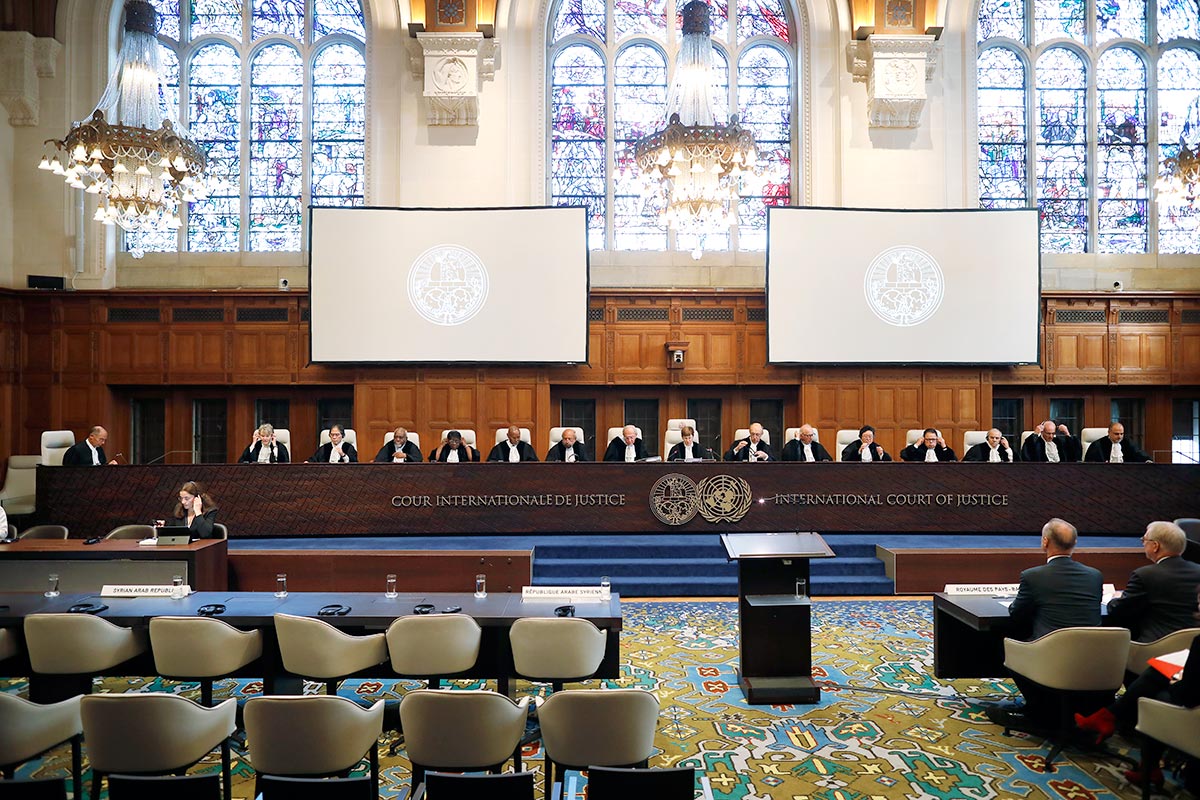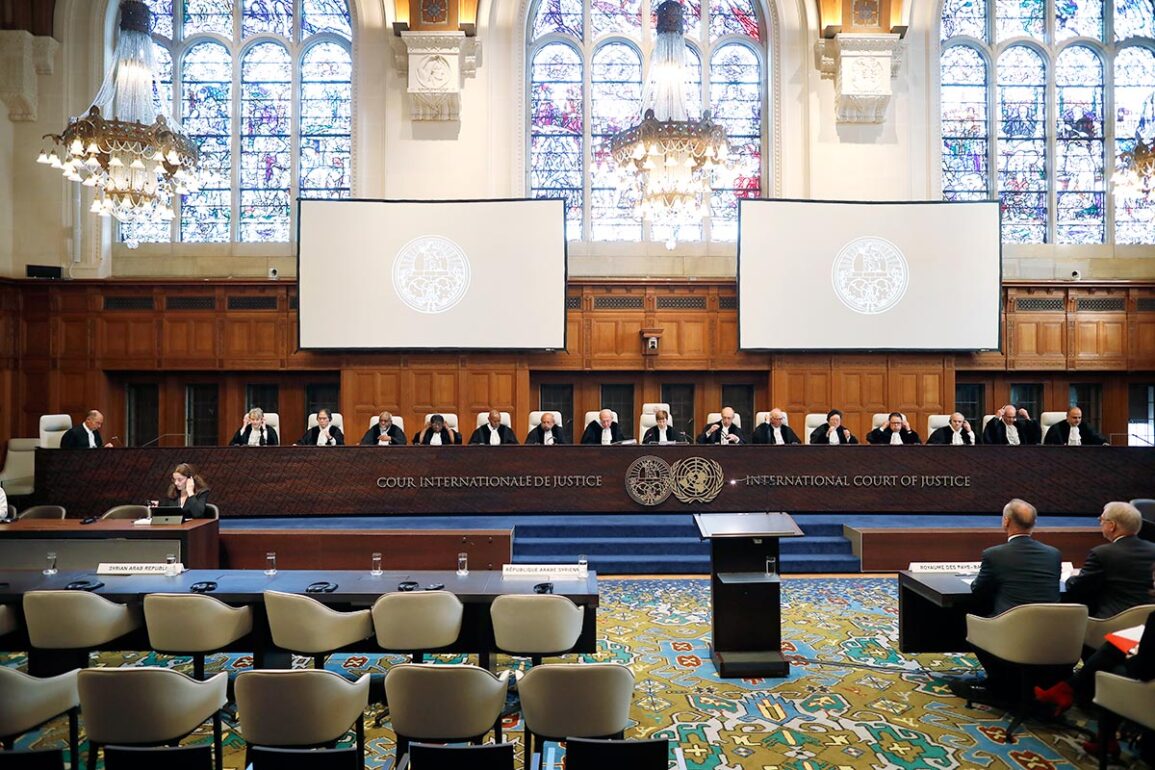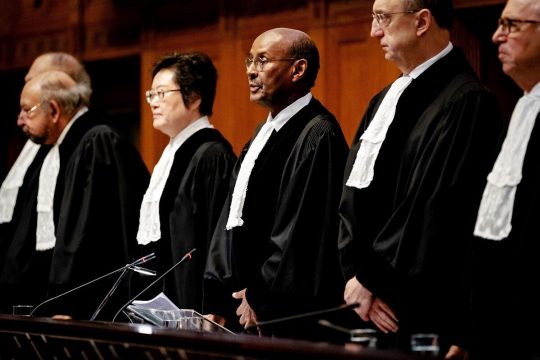“We trust in international law.” These were the words of Alan Kessel, representative of the Canadian government before the International Court of Justice (ICJ), during a post-hearing press conference on the steps of the ‘Peace Palace’ on 10 October. Standing mere feet away from Kessel, outside the grandiose building, surrounded by carefully manicured lawns and flowerbeds, I struggled to hear him. Outside the gates, chants of ‘Hurriyah, Hurriyah, Hurriyah’ (Freedom, Freedom, Freedom), rose loudly as Syrian flags waved. Kessel’s pledge of allegiance to ‘international law’ was a response to a specific question from a reporter: “The Syrians didn’t even turn up today, what makes you think they would adhere to any measures demanded by the court?”
This question is the subtext of this entire legal dispute. It is a key tension underlying this attempt to hold the Syrian government accountable for torture under international law. Survivor and activist groups outside the Peace Palace seemed both wholeheartedly realistic about what the court can ‘achieve’ (i.e., next to nothing), and yet incredibly positive about the case. Grappling with this paradox involves reflecting on the aspirations, inspirations, and imaginations ascribed to international legal proceedings.
What is the importance of a legally dense, technical procedure? Particularly one in which one of the parties (Syria) refuses to show up? What can such a dispute, in such a specific arena, provide?
The International Court of Justice is an instrument for adjudicating disputes between states. Historically, this has entailed judging land or sea border disputes, questions of territorial sovereignty, and disagreements over the legality of the use of force. Despite consistent mix-ups in the press, the ICJ is not the International Criminal Court (ICC). The ICC styles itself as a tool to end impunity through internationalised, individualised, criminal justice. It sits in a glass-fronted stronghold whose interior would make an Ikea showroom-designer envious. The ICJ – three kilometres away – sits in a palatial building with a cathedral-esque interior replete with stained glass windows, domed ceilings, and Latin inscriptions beneath relief carvings of ‘veritas’ (truth) and ‘justitia’ (justice). If the ICC is a secular shrine to individual criminal responsibility, justice for victims, and reckoning with atrocity crimes, the ICJ is a temple of genteel treaty disputes, legal technicalities, and obscure Latin phrases.
In recent years, however, innovative legal practitioners have begun to use the court as an arena to reckon with atrocity crimes which do not directly impact the states bringing the issue to court, such as genocide (in the case of The Gambia v. Myanmar) and torture (Canada and the Netherlands v. Syria). Canada and the Netherlands are addressing the issue of torture in Syria in terms of a treaty dispute. All three countries are party to the ‘Convention Against Torture and Other Cruel, Inhuman, or Degrading Treatment or Punishment’ (CAT). Article 2 of the Convention states that “each state party shall take effective legislative, administrative, judicial or other measures” to prevent torture on any territory under its jurisdiction. The legal principle of erga omnes partes (one such obscure Latin phrase, literally translated as ‘towards all parties’), allows any country that is party to a convention such as the CAT to bring a legal case for violations which may not directly affect them. The argument in such cases is that parties to a treaty or convention have obligations to all other parties, and if they do not fulfil those obligations there exists grounds for a legitimate legal dispute. It was under the principle of erga omnes partes that The Gambia – a tiny country in West Africa with a population of approximately 2.5 million – could bring a case against Myanmar, the largest country in Southeast Asia with a population of 55 million, for alleged violations of the Genocide Convention.
In this instance, Canada and the Netherlands have asked the court to rule on 7 overarching ‘provisional measures’, designed to put an end to ongoing torture and related human rights violations carried out by the Syrian government against the Syrian people.

Optimism in verbal paraphernalia
The prospect of the International Court of Justice as an arena for reckoning with atrocity crimes has been welcomed with optimism by many. The discourse around the Syria hearings provides proof of this. Human Rights Watch referred to it as a “watershed” moment, and “an opportunity to scrutinise Syria’s long-standing heinous torture of countless civilians”. The Dutch Ministry of Foreign Affairs called it a “crucial step towards achieving truth, justice, and accountability”. These exact words were echoed by Canadian Foreign Policy outlets. Academics applauded the fact that the case was going ahead, claiming it as proof that the ICJ can be a “new tool for enforcing human rights”.
This optimistic, action-based language stands in stark contrast to the procedural minutiae of the court itself. When the 15 ICJ judges entered the courtroom and sat down, President Joan E. O’Donoghue (USA) reeled off a procedural history of the submissions of the parties. There was no reflection on the significance of the case, no tributes to ‘justice’, ‘truth’, or ‘ending impunity’, no acknowledgement of the packed public gallery or the (presumably) significant online audience. The judges’ demeanour seemed to indicate that this was a technical legal procedure – almost surgical in its precision – and would be conducted as such.
With an absence of verbal fanfare that contrasted starkly with the opulence of the setting, the Netherlands and Canada began their submissions. Representative of the Netherlands René Lefeber announced that his team had “elected not to show you images of victims of torture” as this could “unnecessarily sensationalise” their request for provisional measures. Other than a few rhetorical flourishes, the case presented to the judges’ bench and the empty chairs of the Syrian representatives was clinical, and heavy with legalese. Sitting in this austere courtroom, I struggled myself to wade through the verbal paraphernalia of jurisdictional and rights-based questions at hand. Looking at the conspicuously empty seats of the Syrian delegation and considering the ICJ’s lack of power to enforce the provisional measures it may hand down raised the question of how optimistic, activistic, nonlegal aspirations could coexist with the court’s self-imposed sanitised, purely legal discussions.
What’s the meaning of it?
Sitting in the packed ‘Van Gogh’ conference room at the Marriott Hotel on Wednesday 11 October, I listened to a roundtable organised by Syrian survivor-led organisations. All speakers acknowledged the near certainty that the provisional measures would not be enacted and could not be enforced. The focus was on these proceedings as a “first step”. For some, it was a first step towards eliminating the false narratives of the Syrian regime. For others, it was about shifting the balance of power from the regime to the people. Most intriguingly was the view of these proceedings as a “first step” on the road to the ICC, which would be “the dream for many Syrians”. The ICC, currently, has no jurisdiction over violence in Syria, as Syria is not a party to the Rome Statute. The individual focus of the ICC means that even with jurisdiction, it was deemed as a route to ‘justice’ that is both desirable and problematic.
Protesters outside the Peace Palace stood with a banner that called for the trial of the “chemical criminal” Assad. At the same time, torture survivor Ahmad Helmi claimed that Assad’s imprisonment would not be enough. The issue for him was that “torture in Syria is a curriculum, is a system”, and therefore “the state has to be held accountable”. Assad is the face of state violence in Syria, and to a large degree without his accountability many will not perceive ‘justice’. The systematised nature of the violence in Syria means, however, that it would be impossible to truly account for criminality through the lens of judging just one individual, no matter how powerful. This, then, is where the ICJ’s atrocity crime paradox peaks. The International Court of Justice as a tool for addressing atrocity crimes is an enigma: both powerful and inadequate.
If there is a possibility for the ICJ to address – in narrative if not legal terms – the structural violence for which the ICC is so ill-equipped by virtue of its focus on individual actions rather than systems, there needs to be a reckoning with the limits of its abilities. Perhaps both Alan Kessel and Syrian survivors “trust in international law” in this case. But if Kessel trusts that the law (and specifically the ICJ’s enactment of the law) can hand down an abstract ‘justice’ to Syrians, the survivor and activist community have a more nuanced view. This community appears to trust that not the law, but the spectacle of the law, will elevate their narrative, invite discourse, and bestow legitimacy. Ultimately the ICJ may become, in atrocity crimes cases, an engine of meaning-making rather than of legal responsibility. The real battle then will not be over jurisdiction, but over who grants legitimacy to the narratives of the court.
“We as survivors are also evidence”
In the case of Canada and the Netherlands vs. Syria, the Syrian government has tried to deny legitimacy to the court’s meaning-making by refusing to attend the hearings. The International Court of Justice as an institution asserts legitimacy of meaning through its long history, grand setting, and legal prowess. Legal representatives for Canada and the Netherlands try to create meaning through the perceived inherent legitimacy of their cause, and their ability to weave intricate legal arguments using precedent, statutes, and technical legal language. It remains to be seen how this meaning-making and battle for legitimacy will play out in later hearings. But for the Syrian diaspora and survivor communities outside the Peace Palace gates, the spectacle of the hearings gave them a kind of embodied legitimacy. They saw the court not as an end in itself but as a means, “another tool that we can use”. They are sceptical of the court’s power, yet optimistic that its narratives can set them, as a community, on the “path of justice”. As one survivor remarked: “We are also a memory. We as survivors are also evidence.”
Recommended reading




PhD Researcher at University of Amsterdam and NIOD Institute for War, Holocaust, and Genocide Studies, examining the construction of historical narratives within international criminal trials.
This post was originally published on this site be sure to check out more of their content.










